2 or 3 or 4 or 5 or 6 or ... things I know about Yoriko Douguchi
(日本語訳は こちら)
by Dr. Yumekage (
Yoriko Douguchi (In Japan, we pronounce her surname 'doh-guchi', with the accent on the first 'DO')
is an actress who is an icon for many film buffs and filmmakers
who prefer alternative/ independent Cinema to Japan's main stream cinema.
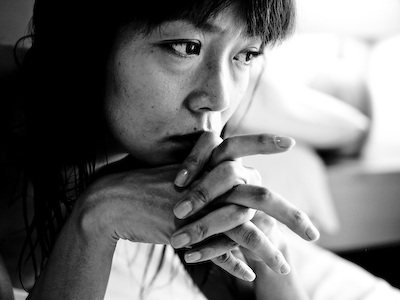
Her distant beauty, somber gaze and sensuous elusiveness
bring a shadowy sense of emotion to the silver screen,
bolstering filmmakers' aspirations of capturing the mysterious moments of cinema.
Douguchi is known for more than just her work in alternative/independent cinema.
She is also a popular actress among fans of prime-time detective/crime dramas on TV,
which are called "ni-jikan sasupensu " (two hours of suspense).
In these kinds of TV dramas, she often appears as a suspected person or an unfortunate heroine.
For many "ni-jikan sasupensu" fans, Douguchi is ranked high as a "favorite offender ".
Ex-Fan des Sixties
Born March 18, 1965, in Tokyo,
Douguchi was entranced by the Beatlesat the age of 12,
loving everything from their early hits to their late progressive tunes.
She soon found her way to other rock bands from the 60s,
such as the Yardbirds, the Kinks, the Beach Boys,
and ultimately became intrigued by the Zeitgeist of the tumultuous atmosphere
of the late 60s and the early 70s.
Within a few years, her tastes in music became more catholic,
with her favorites including legendary musicians such as Django Reinhardt and Les Paul,
as well as Japanese New Wave bands such as the Plastics, P-Model and Hikashu,
and even eccentric cult figures such as Captain Beefheart and the Residents.
At the same time, Douguchi aloso became fond of various sorts of films
-- in particular, the French Nouvelle Vague Cinema.
When she was 17, she became fascinated with the films of Jean-Luc Godard.
Anna Karina, the femme fatale of Godard's films, burst into Douguchi's adolescent consciousness
and has since exerted a crucial influence on her life.
Takin' Off
At the age of 15, Douguchi was chosen as the cover girl for the November 7 issue of "Shuukan Asahi " magazine.
This (dressed) cover photograph was taken by Kishin Shinoyama , the most famous photographer in Japan,
whose best known work internationally may be the photo used on the cover of
John Lennon & Yoko Ono's "Double Fantasy" LP.
In 1983, after having graduated from the high school,
Douguchi posed in several undressed photo sessions for "Gekisha ",
which was Shinoyama's photo serial on "GORO " magazine.
"GORO " magazine had a large circulation.
Shinoyama's "Gekisha" photos had been very popular among young men since the middle of the 70s.
Douguchi became one of their beloved pinup idols.
The Excitement
In 1984, when Douguchi was 19, her life came to its first turning point when she was starred in a major role
in a "roman poruno " (romantic porn) film.
"Roman poruno" is a brand of sex-oriented films by Nikkatsu, the oldest film production company in Japan.
Most of them were low-budget films, featuring obscure young and interesting actresses, actors and filmmakers.
Some of their works won acclaim for their quality in the 70s in particular.
Douguchi's debut film was directed by a young and promising director named
Kiyoshi Kurosawa (no relation to Akira Kurosawa).
Its working title was "Joshidaisei Hazukashi Zeminaaru" (A coed taking a seminar on shyness).
Although Douguchi still had some qualms about playing a major role in a roman poruno film,
she was also excited to work with young and relaxed people
who were heavily influenced by Godard and Nouvelle Vague as well.
Unfortunately, Nikkatsu, the film company, refused to release the film,
due to its not being lascivious enough for a (softcore) porn film.
Despite the efforts of Kurosawa and his supporters to purchase the film back from Nikkatsu,
some sexual sequences had to be cut from the original version
to pass the censors as a general (non-porn) movie.
Moreover, to make up for the missing sequences, other new sequences needed to be filmed.
In 1985, when Douguchi's debut film was eventually shown, it had been reborn as a completely new film,
"Doremifa Musume no Chi wa Sawagu"
(The Excitement of the Do-Re-Mi-Fa Girl, or Bumpkin Soup ).
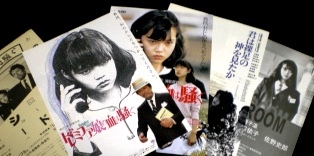
↑(From the left, three differnt kinds of "Chirashi" flyers for "Doremifa Musume no Chi wa Sawagu",
one for "Kimi wa Hadashi no Kami wo Mitaka" and another for "Heya")
For Sale
While there was much discussion of its pros and cons,
"Doremifa" was acclaimed as one of the most unique and brilliant films of the year.
Yoriko Douguchi suddenly became one of the icons for the new generation known as "shin-jinrui" (new humankind).
In the same year, she was also in "Tanpopo" (Tampopo) , the second film from the actor/director Juzo Itami ,
who had also worked with Douguchi in "Doremifa" (as an actor).
In "Tanpopo" and "Marusa no Onna 2" (A Taxing Woman's Return), the subsequent film directed by Itami,
Douguchi attracted the attention of many people in addition to the audience who knew her from "Doremifa".
Throughout the 90s, Douguchi worked regularly.
Her career included roles in both alternative/indepent and main stream productions.
On the whole, it was a prolific decade for her.
In 1992, Douguchi was in a TV serial drama called "Ai to Iu Na no Motoni" (In the Name of Love).
In this coming-of-age drama about a goup of seven post-collegiates,
Douguchi played the role of Noriko, an average girl who works at a department store.
This drama was such a big hit that it had the highest audience rating of any show that year, 32.6%,
and this undoubtedly brought her tremendous success, fame and popularity.
In addition, throughout the 90s, she was one of the most familiar stars of detective/ crime stories on TV.
In addition, her acting in "Kura " (Sake Cellar, 1995) was widely acclaimed
as the most outstanding performance of that TV drama by both critics and viewers.
In 1993, she starred in Shion Sono 's cult movie "Heya"(The Room).
Douguchi's quiet voices and stony expression convey a deadpan sense of humor,
while adding a mournful tone to the whole black and white composition.
Her second turning point came in the mid 90s, with her oldest confrere, Kiyoshi Kurosawa.
Kurosawa was making a series of low-budget films, the "Katte ni Shiyagare"(Suit Yourself or Shoot Yourself) series.
Douguchi appears in every title in that series, as a mysterious woman named Yumiko Haneda.
In the "Katte ni Shiyagare"series, Douguchi shows a more sophisticated beauty than her in "Doremifa Musume",
her earliest work with Kurosawa.
In 1997, Kurosawa's "Cure"(Cure) gave another boost to Douguchi's career.
She improved significantly in this film.
She is in only one episode of the haunting thriller,
but Douguchi's off-kilter sense of acting expresses vulnerability and the collapse of her identity,
and even brings a sleepwalker's nightmarish vision into the whole body of the film.
"Cure" brought Kurosawa to international recognition.
In 2000, Kurosawa's "Karisuma"(Charisma) was released.
In "Karisuma", an enigmatic and allegoric tale about a tree,
Douguchi plays Chizuru, the younger of the Jinbo sisters.
Douguchi achieves success in this highly ambiguous role
that combines nymph-like playfullness and little-devil craftiness.
The essence of Douguchi is fully and unmistakably revealed in this film.
A Bout de Souffle
In 2004, she was diagnosed with uterine cancer
and had an operation to have her ovaries and womb removed.
She had married a TV director in 1997 and they were childless.
Because of Douguchi's brush with death, she experienced so much depression and despair
that she became dependent on alchol and even attempted suicide.
During her long and difficult recovery, she finally found some small but definite peace of mind,
when she visited friends in Okinawa.
Hayashi Toma, a director of an omnibus Okinawan film "Pineapple Tours" (Pineapple Tours, 1992),
which features Douguchi, was among the friends.
He wrote the scenario of an upcoming Internet movie that starred Douguchi in the lead,
a pregnant woman.
It was an ordeal for Douguchi to play this part, but she knew she had to get through it.
She played the role, and came to understand herself better.
This "Tantei Jimusho 5 Another Story File 7 MacGuffin"(Private Eye No.5, Another Story File No.7 "MacGuffin")
became her comeback movie.
Sauve qui peut
In 2007, Shogakukan published a book by Douguchi called "Shikyuu Kaigi"
("The Womb's Conference", named after "The Animals' Conference " by Erich Kästner).
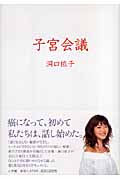
↑("Shikyuu Kaigi")
"Shikyuu Kaigi" is a semi-biographical story
that deals with everything from Douguchi's childhood to her struggle against the uterine cancer.
Despite its saddness, Douguchi's storytelling has a dark sense of humor
and is somewhat influenced by magical realism,
which blurs the boundaries between imagination and documentary storytelling.
It is as unique as Douguchi's cinematic existence.
"Shikyuu Kaigi" has been acclaimed as a creative and imaginative book by critics,
and is also viewed as a supportive book by many uterine cancer patients.
In 2007, Douguchi debuted in a band, enhencing her career further.
It's a ukulele band called Paititi, which features primarily Douguchi and Hidenori Ishida.
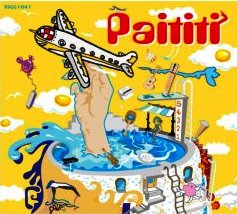
(Paititi's debut album called Paititi)
With several other musician friends,
they play not only Hawaian music but also an amalgam of various kinds of music,
influenced by Reinhardt's virtuoso performances, Beatles' melodies, Weather Report's funkiness, and more.
Paititi's music should be called "crossover ukulele".
They released their debut album "Paititi" in 2008.
(See their gigs at YouTube:http://jp.youtube.com/view_play_list?p=542DDA0AF526379C)
(Paititi's page @ My Space )
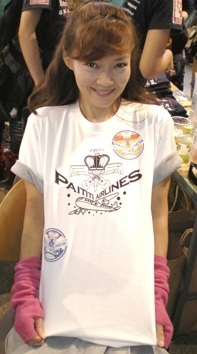
(Yoriko smiling in Paititi T-shirts)
(Paititi in Okinawa, 2008)
In 2008, Douguchi has appeared in several more films/ TV dramas.
She also writes columns for newspapers and magazines.
In addition to these works, another of her impotant activities is "the Reading Session ".
The Reading Session is a reading of her book ("Shikyu Kaigi") with music,
involving a guitarist named Falcon.
They have already had seven successful sessions
in Tokyo, Saitama, Osaka, Hokkaido, Okinawa and Hiroshima.
/ La vie
Yoriko Douguchi is busy and active today.
In 2009, a two week long film festival to celebrate the 25 years of Yoriko Douguchi's film career is was held
at Cinemavera Shibuya, a movie theater in Tokyo, from November 7 to November 20.
It was titled as YORIKO DOGUCHI FILM FESTIVAL.
12 films and 2 very rare TV programs out of her filmography were screened.
Kishin Shinoyama's newly-produced "digi+KISHIN, Yoriko Douguchi" was projected on the big screen.
Shinoyama was also present in person not only as a guest for a special event, but also as an audience of his newest work,
and surprisingly for the "Spanish-style (according to Douguchi's words)" closing ceremony.
Kiyoshi Kurosawa appeared on stage to have a congenial chat with Douguchi, talking of some backstage-episodes from "Do-Re-Mi-Fa" shootings.
Paititi had a small but creative session with Etsuko Yakushimaru (from a band SOUTAISERIRON), a young admirer of Douguchi.
During the two weeks, Cinemavera was filled with an 'excitement' for/by the Do-Re-Mi-Fa Girl.
Douguchi did succumb to the agony of loss at once, but now she often says,
"Although the darkness is still around, I've learned how to cope with it" .
She's as mysterious as she used to be, and more attractive than ever.
She's become tougher, and it definitely enhances her beauty.
It is what she's got, isn't it?
|
YORIKO |